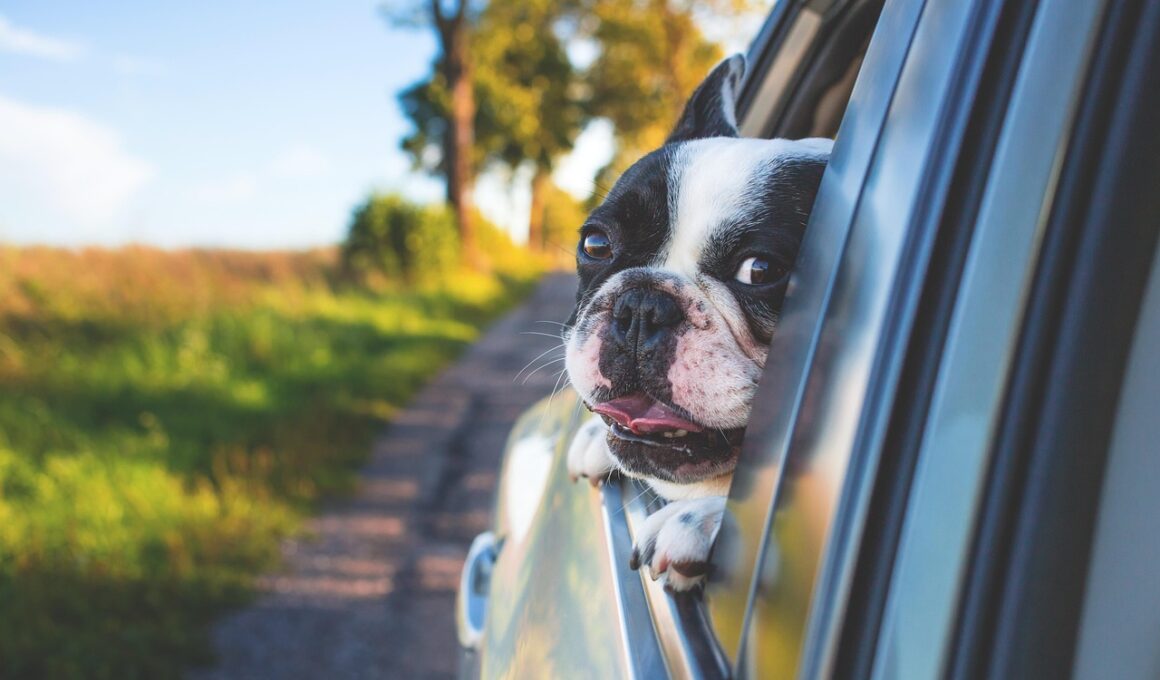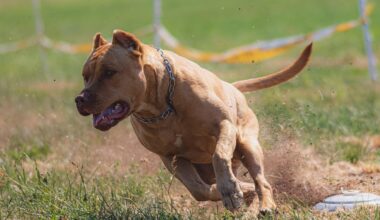Avoiding Common Mistakes When Driving with Dogs
Traveling by car with your dog can be an enjoyable experience, but it also comes with its own set of challenges. One common mistake owners make is failing to secure their dog properly in the vehicle. A dog that is left unrestrained can become a serious distraction while driving. Not only does this put the driver at risk, but it can also endanger the safety of the dog and passengers. To avoid this mistake, consider securing your dog with a harness or using a pet seatbelt. Some might also choose a secure cage or crate. Each option has its own benefits, but it’s essential to find what works best for your dog’s size, temperament, and the length of the trip. Planning is key when traveling with pets as well. Ensuring you have enough breaks to allow your dog to stretch can prevent anxiety. Also, keep water and favorite toys accessible to make the journey more comfortable for your furry friend. Traveling should be a bonding experience filled with fun, so avoiding these common mistakes can help ensure a smooth ride.
Another common error is not planning for bathroom breaks, which can lead to unnecessary accidents in the car. Dogs, like humans, need regular bathroom breaks, particularly on long journeys. Plan to stop every few hours to let your dog relieve itself. Take this opportunity to hydrate your pet and provide some light exercise. A leash is important at rest stops to keep your dog secure. Never let them off-leash in unfamiliar areas, as they could easily run away. It’s also a good idea to research pet-friendly locations along your route. This not only helps in finding suitable rest areas, but it can also give your dog some much-needed stimulation. Overlooking this can lead to stress for both you and your dog. Furthermore, being aware of the weather conditions is crucial when traveling. During hot days, make sure your car is properly cooled and provide enough water. Protecting your dog from extreme heat is important for their health. On colder days, ensure they are warm enough. Knowing the weather can help create a safe traveling environment for your canine companion. Remember, preparation is key!
Food and Hydration for Your Dog
Feeding your dog right before a long car ride can lead to nausea and potential vomiting, so be careful with their dietary setup during travel. It’s usually best to feed them a few hours before your departure to avoid these unpleasant occurrences. Also, don’t forget to bring along their usual food for the journey to keep their stomachs stable and predictable. If you’re on a long trip, pack enough food to last the whole journey. Measuring portions can help maintain a regular eating schedule. Another crucial factor is ensuring your dog stays hydrated while on the road. Bring plenty of water along and a portable dish to make it easy for your dog to drink during pit stops. Dogs can get restless without sufficient hydration, which could lead to car sickness. Frequent hydration breaks are essential, especially in warmer months. Always carry a spare water bottle for yourself. Remember to offer them drinks during breaks to keep hydration levels optimal. It’s incredibly important for your dog’s overall health and well-being during your travels.
Another mistake many pet owners make is neglecting their dog’s comfort during the drive. Installing the right seat cover or using protective bedding can help keep your dog feeling secure and comfortable. Additionally, create a cozy space where they can relax. This may include their favorite blanket or a few toys, as these can help alleviate anxiety during the trip. Likewise, using calming aids like pheromone sprays or anxiety wraps can help soothe your dog. Ensure that they have ample space to lie down without feeling cramped, especially for larger breeds. Another essential aspect is to maintain the optimal temperature inside your car. Ensuring adequate ventilation, especially in hotter months, prevents overheating. At the same time, ensuring it’s not excessively cold can also keep them comfortable. Dogs have varying degrees of tolerance to temperature extremes, so keeping a watchful eye on your dog’s behavior can clue you in if they are feeling too hot or cold. Comfort is vital for fostering an enjoyable travel experience for both you and your dog, ensuring you make memorable journeys together.
Safety Precautions While Driving
Driving with a dog comes with several safety precautions that every owner must consider. One major mistake is leaving windows wide open, allowing dogs to stick their heads out. While it may seem fun for them, this can be incredibly dangerous. Sudden stops or high-speed travel can lead to fatal accidents. Instead, consider cracking the windows to let in fresh air while preventing any mishaps. Also, ensure that your dog has proper identification, such as tags, in case they somehow escape during stops. Microchipping is also a wise choice and serves as an extra layer of security. In case of emergencies, carrying health records and important contacts is a good idea. If your pet has any special medical needs, you should carry medications in an easily accessible place. Make sure to keep a first-aid kit handy, which can be incredibly helpful if an accident occurs during the journey. First-aid kits should include basic supplies like roller bandages, antiseptic wipes, and scissors. These safety measures can greatly reduce the risks involved while driving with a dog.
You may also overlook the emotional aspect of traveling with your dog. Dogs may feel anxious or stressed when placed in new environments or situations. Ensuring a smooth adjustment during the journey requires you to pay attention to your dog’s behavioral cues. Some dogs prefer to be crated, while others might be more comfortable sitting on the seat beside you. Understanding your dog’s preferences is crucial for a stress-free travel experience. Avoid bringing too many changes along, as familiarity can often make the trip easier. A new toy or chew can provide comfort, but too many new things can overwhelm them. During the journey, speak soothingly to your dog, as your tone can have a calming effect. Having music that relaxes them can also help. If possible, take short breaks for bathroom or playtime, giving your dog mental stimulation, which can ease anxiety levels. Keeping your dog’s spirits high during the journey is a great way to ensure they remain calm and happy. Remember, the goal is to enjoy your travels together while avoiding stressful situations that may arise unexpectedly.
Planning Ahead for a Smooth Journey
Lastly, never underestimate the importance of planning ahead when traveling with your dog. Before you embark on your journey, ensure the car is in excellent condition. This means checking tire pressure, oil, and petrol levels. An unexpected breakdown can lead to unnecessary stress for both you and your dog. Planning your route in advance can also help minimize travel time and identify suitable stops along the way. This can help you avoid congested roads or high-traffic areas, ensuring you reach your destination without complications. Internet resources can provide insights into dog-friendly accommodations. Also, prepare for emergencies by noting nearby veterinary hospitals along the journey; knowing where they are can help you deal with unforeseen medical situations promptly. Sometimes unexpected weather phenomena can arise, so be flexible with your travel dates. Additionally, packing essentials such as food, water, toys, and first-aid supplies ahead of time will ease potential last-minute worries. A well-planned trip can turn a long drive into a pleasing adventure. Thus, understanding various facets contributes significantly to successful journey experiences.
Initially, many people may view traveling with dogs as a challenge rather than an enjoyable experience. However, by avoiding common mistakes and taking necessary precautions, it can transform into a delightful adventure. It is essential to remember your dog’s unique needs, such as food, hydration, and comfort requirements. Similarly, ensuring their safety and emotional well-being is vital for a smooth ride. Taking the time to prepare thoroughly can make a significant difference in how enjoyable the trip will be for both you and your furry friend. Utilize the tools available to help your dog feel secure and happy during the voyage. Take breaks, allow them to explore, and engage with them throughout the journey. Positive reinforcement can turn potential stress into excitement and learning experiences. Reinforce this good behavior while on the trip. In conclusion, as long as you consider your dog’s needs and make arrangements to cater to them, driving with your dog can be a fulfilling experience. Unforgettable memories await if you plan your trip considering both of your needs, leading to an enduring bond between you and your canine companion.


